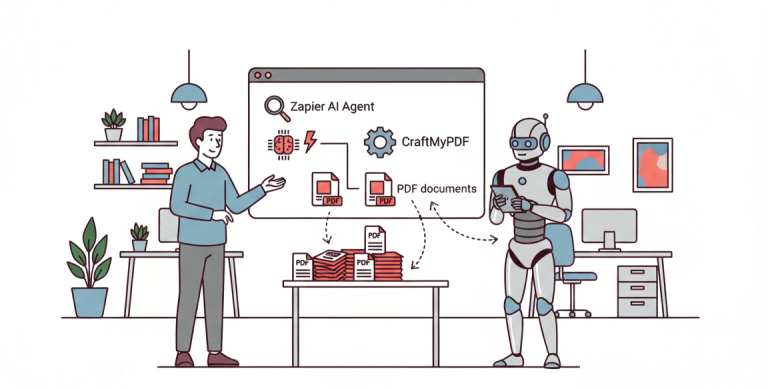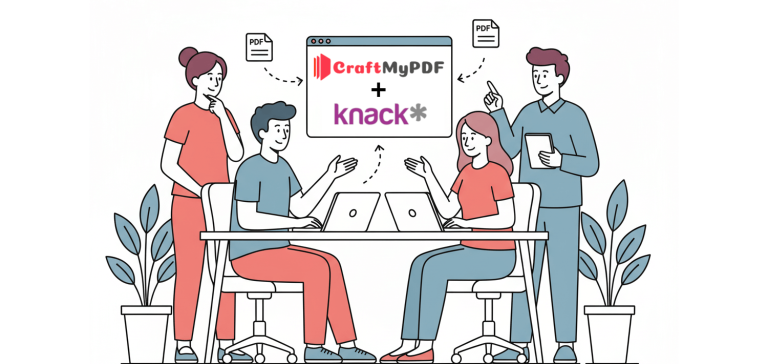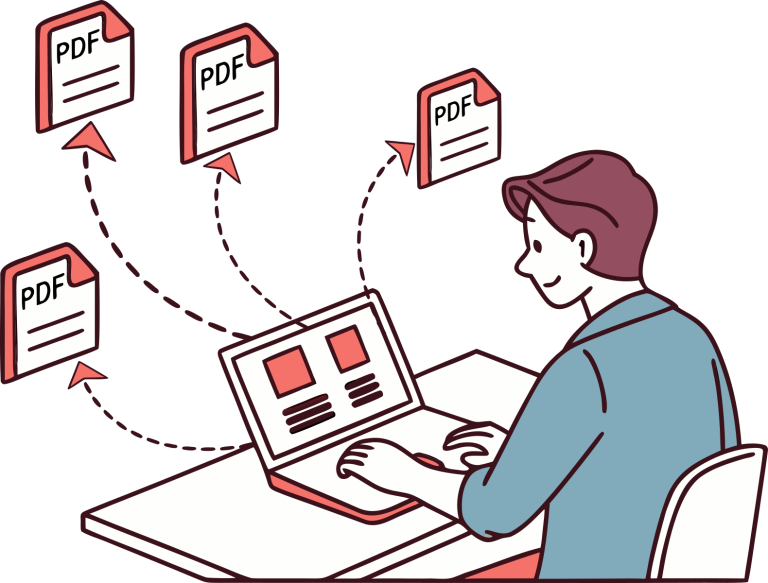Real‑estate professionals juggle a staggering number of documents every day.
These include marketing brochures, listing agreements, lease contracts, purchase agreements, inspection reports and disclosure statements.
Manually preparing these documents is time‑consuming and error‑prone, especially when you need to personalize each one for different clients or properties.

Fortunately, CraftMyPDF’s PDF generation API can automate document generation while maintaining your brand and ensuring compliance.
In this article, you’ll discover two template‑building methods to streamline real‑estate paperwork and learn how CraftMyPDF integrates with popular no‑code tools to transform your workflow.
Why Automate Real‑Estate Documents?
Streamlined workflows: Manual document creation slows down your sales pipeline. Automating repetitive tasks frees agents and property managers to focus on negotiations and client relationships rather than formatting PDFs. With CraftMyPDF you can generate brochures, contracts and other property paperwork in seconds, reducing delays and improving customer experience.
Accuracy and consistency: By pulling data directly from your CRM or property‑management system into your templates, you eliminate typos and inconsistencies.
Fields like addresses, prices, dates and terms are populated automatically. Consistent formatting and branding across all your documents reinforce professionalism and trust.
Environmental and cost benefits: Automated PDF generation cuts down on paper usage, printing costs and physical storage. Digital storage also makes it easier to search and archive documents for future reference.
Faster turnaround and time savings: Automated document workflows speed up every stage of the process. With pre‑built templates and automated approvals, tasks that once took days can be completed in hours. You can create agreements, contracts, invoices and other paperwork in minutes, ensuring clients receive documents quickly and deals progress without unnecessary delays.
Minimizes mistakes and ensures compliance: Using standardized templates reduces human error and ensures that important legal terms are never overlooked. Automated systems also make it easier to adhere to legal standards and internal policies, reducing the risk of non‑compliance.
Scales effortlessly and improves collaboration: Automated systems can generate hundreds or thousands of documents without extra work. They centralize your templates and contracts, enabling your team to access and collaborate on them in real time. Improved visibility reduces miscommunication and keeps everyone on the same page
Understanding Real‑Estate Documents
The real‑estate industry uses a wide variety of paperwork. Some of the most common documents include:
- Property listing agreements – contracts between property owners and agents that outline terms for marketing the property.
- Lease agreements – legal documents detailing payment schedules, duration and responsibilities between landlords and tenants.
- Purchase agreements – formal contracts that specify the price, contingencies and closing details of a property sale.
- Rental applications, disclosure statements and inspection reports – forms that collect tenant information, disclose property issues and document property condition.
- Marketing brochures – polished, image‑rich documents showcasing properties to potential buyers or tenants.
- Property valuation reports – professional assessments of a property’s market value prepared by licensed appraisers.
- Brokerage agreements – documents outlining the relationship between a client and a real estate brokerage, including services and commission structures.
- Loan agreements – contracts between lenders and borrowers specifying the terms of mortgages or property loans, including repayment schedules and interest rates.
- Certificates of occupancy – documents issued by local authorities certifying that a building complies with codes and is suitable for occupancy.
- Real estate investment proposals – detailed proposals describing investment opportunities, financial projections, risks and returns
Automating these documents requires flexible templates that can accommodate both structured data (like numbers and dates) and rich content (such as photos, signature fields or detailed legal clauses) while ensuring accuracy and compliance.
Two Ways to Build Templates in CraftMyPDF
CraftMyPDF lets you build templates in two distinct ways, each optimized for different document types. Below, each method includes a brief introduction, step‑by‑step instructions and a summary.
Method 1. Import an Existing Design (Great for Brochures)
This method is ideal when you already have a beautiful brochure design created in Canva, Adobe Illustrator or another design tool.
By importing the design as a PDF into CraftMyPDF, you retain control over your layout and branding while adding dynamic data fields. It’s perfect for marketing materials that rely heavily on graphics and typography.
The followings are the steps:
Step 1. Design your template in Canva or another tool. Create a brochure that reflects your brand and include high‑quality photos, property descriptions and your contact information. When finished, export the design as a PDF.
Step 2. Import the PDF into CraftMyPDF. In the CraftMyPDF dashboard, click “New Template from PDF file” and select your exported brochure. This imports the layout exactly as it appears in your design tool.

Step 3. Edit the imported template. Click “Edit” to open the template for customization. Use the drag‑and‑drop editor to overlay dynamic components and labels for property address, images that pull in property photos, QR codes linking to virtual tours or listing pages.
Step 4. Add data fields and expressions. In the Data tab, define JSON variables for details like address, price, number of bedrooms and realtor contact.
Back in your template, select each label and click “Insert Data Expression” to bind it to the appropriate variable. Use expressions to format currency and dates or to perform calculations (e.g., converting price to local currency).
Step 5. Test and refine your brochure. Generate a sample PDF using test data to ensure the dynamic fields appear correctly. Adjust positioning or formatting as needed for a professional look.
Step 6. Automate brochure generation. Integrate the template with Zapier, Make.com or Bubble.io so that whenever a new listing is added to your CRM, CraftMyPDF generates a brochure automatically. You can then email the PDF to prospects or upload it to property listing sites.
To learn about how to import a PDF as template, please view our detailed blogpost here
How to Create Dynamic PDFs or Images With Canva’s Designs
Importing an existing design lets you preserve the polished layout you created in Canva while adding dynamic content with CraftMyPDF.
This method is ideal for brochures and other marketing collateral because it combines professional design with automated data population and seamless integration into your sales workflows.
Method 2. Start from a Template with a Word‑Like Editor (Ideal for Contracts)
Contracts and other legal documents are primarily text‑based and require precise formatting, clause management and dynamic variables.
CraftMyPDF’s HTML component includes a built‑in WYSIWYG (What You See Is What You Get) editor, which functions like a Word processor. It allows you to compose contracts directly inside the template editor, apply styles, insert lists and tables, and embed dynamic data fields.
The Steps of Creating a new template:
Step 1. Create a template. In the CraftMyPDF dashboard, start a new template instead of importing a PDF. Select Business Contract and this gives you a clean canvas for drafting your contract.

Step 2. Add the HTML component or Double click on the HTML component. Drag the HTML component onto your canvas and double‑click it to open the WYSIWYG editor. Here you can type or paste your contract text. Use built‑in controls to apply bold, italics, underline, headings, bullet lists and numbered lists. Insert tables to display payment schedules or fee breakdowns.
Step 3. Insert dynamic fields. Use the Insert Expression feature within the editor to include variables such as buyer/seller names, property addresses, contract dates and total amounts. Expressions let you calculate totals (e.g., rent multiplied by lease term) and format currency or dates automatically.

Step 4. Define data sources. In the Data tab, prepare a JSON schema that includes all variables referenced in your contract. This ensures the template knows where to pull each value during generation.
Step 5. Preview and adjust formatting. Generate a test PDF with sample data to check line spacing, table alignment and overall readability. Tweak your template until the document looks polished and professional.
Step 7. Automate contract generation. Connect your template to a workflow platform like Make.com or Bubble.io. When a deal moves to the contract stage, the integration triggers CraftMyPDF to generate a customized contract and sends it to the parties for review and signature.
Starting from a blank template with the WYSIWYG editor allows you to craft professional contracts with full control over formatting and clauses. You can embed dynamic expressions for names, dates and calculations and add interactive elements like checkboxes and signature fields.
This method is ideal for leases, purchase agreements and other legal documents where text formatting and data binding are critical.
The Key Features of CraftMyPDF
In addition to the two template‑building methods, CraftMyPDF provides a robust automation toolkit that simplifies every stage of document creation.
It allows you to design professional PDFs, import existing designs, apply complex formatting and calculations, and integrate with other platforms and all while reducing manual errors and speeding up your workflow.
The key features include:
- Drag‑and‑drop template editor – Compose templates visually using labels, images, QR codes, barcodes and charts. You don’t need to know HTML or CSS to design professional documents.
- Import existing PDFs – Reuse your current designs by importing them as templates and overlaying dynamic elements.
- Expressions and formatting – Format currency, dates and numbers and even perform calculations with built‑in expressions.
- Fillable components – Add text boxes, checkboxes, dropdown menus, radio buttons and signature fields to create interactive forms.
- Regional API endpoints – Keep your data within specific regions (US, EU, Singapore, Australia) for compliance. To find out more about our regional API endpoints at API Reference.
- PDF & Image Generation API – A cloud‑based API for generating PDF documents or images (JPEG/PNG) synchronously or asynchronously at scale. This API eliminates the need for you to maintain PDF generation infrastructure.
- No‑code/Low‑code integrations – Seamlessly connect CraftMyPDF with Zapier, Make.com, Bubble.io, Coda.io and other platforms to automate workflows without writing code.
- Embed the template editor – Integrate the CraftMyPDF template editor directly into your own application, giving your users the ability to manage and design PDF templates while reducing your development effort.
Collectively, these features provide a comprehensive platform for designing, generating and automating polished PDF documents.
You can create reusable templates, incorporate dynamic data and calculations, support interactive forms, comply with data‑residency requirements, and scale PDF generation without sacrificing control or quality.
Integration with Zapier, Make.com, REST API and More
One of the biggest advantages of CraftMyPDF is its seamless integration with popular no‑code and low‑code platforms.
CraftMyPDF integrates with Zapier, Make.com, Bubble.io, Coda.io and its own REST API.
These integrations let you trigger PDF creation from events in other apps: such as a new property listing in Airtable or a new deal in HubSpot and automatically generate and send documents.
- Zapier – Build automated workflows (“Zaps”) that watch for new records (e.g., a new tenant application) and call CraftMyPDF to generate a lease agreement or brochure.
- Make.com – Set up scenarios that connect multiple services. For example, when a lead fills out a form, Make.com can pull the data, generate a brochure, store it in Google Drive and send an email to the prospect.
- Bubble.io – Integrate PDF generation into your Bubble application. Users can request personalized contracts or brochures directly through your web app.
- REST API – Developers can call the API directly from custom systems or scripts to generate PDFs asynchronously and retrieve the resulting files. To find out more about our regional API endpoints at API Reference.
These integrations allow you to build powerful automation chains without writing extensive code.
To learn more about the integrations, click here.
The Steps to Get Started with CraftMyPDF
To make the most of CraftMyPDF’s tools, follow these basic steps for designing and automating your documents:
- Prepare your data – In the Data tab, import, manipulate or view your JSON data. Having your data ready up front helps with auto‑completion and previewing the PDF.
- Design your template – Use the Designer tab to modify your PDF template. Drag and drop components and apply expressions (e.g.,
{{ data.[field] }}) to bind fields to your data. - Preview and debug – Before you go live, open the Preview tab to see how your PDF will look and debug any expressions or layout issues.
- Automate generation – Once your template is ready, automate PDF generation using Zapier, Make.com, or the REST API.
Following these steps ensures that your templates are accurate, dynamic and ready for integration into your workflows. You can learn more about the steps in 10 mins with our tutorial here.
Conclusion
Automation can transform the way real‑estate professionals handle documentation. Whether you’re generating eye‑catching brochures or legally binding contracts, CraftMyPDF provides the tools to design, populate and distribute documents quickly and accurately.
With flexible template options, a Word‑like editor, built‑in expressions and seamless integrations with Zapier, Make.com, Bubble.io and REST APIs, you can eliminate manual drudgery and focus on closing deals.
Ready to streamline your real‑estate workflow? Sign up for CraftMyPDF to try the PDF generation API for free, or explore the CraftMyPDF PDF Template Editor to start automating your brochures and contracts today.









